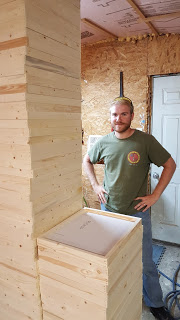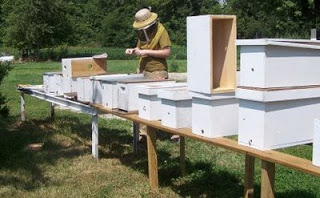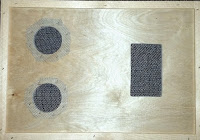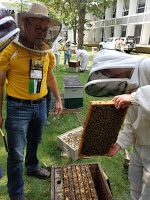Why Are There So Many Queen Issues?
Why do so many hives have queen issues? Hi, we are David and Sheri Burns. I’m an EAS Certified Master Beekeeper and I spend my days and sometimes nights doing nothing but bee stuff. I love it. Here’s our daughter Karee, a few years ago, finding queens. As a family business our children have always been involved in some aspect of beekeeping. We appreciate customers who have supported our family business over a decade now. We know you can go to big box store and buy bee supplies, but we appreciate you giving us your business.
I’m worried that beekeepers are not feeding their bees enough in preparation for winter. Late summer will put most of us into a nectar dearth and bees will consume a large portion of their winter stores. Be ready to feed your bees 1:1 and 2:1 and pollen patties!! We invented an easy way to feed your bees in the fall for winter to help prepare your hives for winter.
The Burns’ Bees Feeding System. Finally a feeding system that overcomes many of the challenges of feeding bees during late winter, spring, summer and fall. This time of the year, many beekeepers fail to keep enough food in the strategic placement within the hive for maximum brood build up. For example, when temperatures reach 50 or below in the spring, say on a cool spring night, the cluster is no longer able to eat from the entrance feeder. And with the recent studies we know that bees need protein (pollen) as much, if not more than, just sugar or sugar water. The Burns Bees Feed System places the food strategically over the brood nest area, keeping food where bees can always access it even on cold nights. What about summer dearth, that period between summer and fall nectar flows? Bees often suffer from a lack of nutrition in the summer and fall. The Burns Bees Feed System keeps both liquid and patties on the hive for maximum preparation for winter. The Burns Bees Feed System includes 2 mason jar FEED CAPS. Does not include mason jars. Use board in place of inner cover. Our new design now has both circle holes in the center rather than side by side.
My week in New Jersey at the Eastern Apicultural Society conference was great. It was so fun seeing old friends and teaching new beekeepers. 18 new Master Beekeeper candidates were taking all four tests (written, lab, field and orals) for the first time. Of those 18, 5 passed all four tests and are now new MBs. 9 candidates were taking one or more tests again attempting to pass. Of those 9, 5 passed their necessary tests and are new MBs. I enjoyed testing new candidates and observing how hard they worked and prepared for three grueling days of testing. You can click on the image to the left for a larger view. The picture shows what the field test day was like. Several certified MBs are seen testing candidates. I’m in the yellow shirt testing a candidate along with MB Alan Hayes. This candidate was nervous but she did really good.
We were busy teaching our „Getting Your Bees Ready For Winter” class on Saturdays. We have one more winter class still open for registrations: Aug. 20th 8:30-1pm And we have one more Beginners Class that we are offering this year on Saturday Oct. 15, 8:00-1pm. It is filling up already, so sign up soon. Click Here For More Information.
Saturday’s students were treated to some of Sheri’s special honey bee cupcakes. Look closely and you’ll see a small bee. Sheri has enjoyed taking some specialty candy and baking classes recently and they are paying off big time for the students in our classes as she tries out her new creations! Did I tell you she is now a certified chocolatier?
Before we talk about queen issues, let me tell you about a cool video series I started called „The 60 Second Beekeeper.” Don’t you hate trying to find a good video to show you how to do something? When you finally find it, it’s 45 minutes long and never gets to the point. You get so lost and bored you don’t even finish watching it. Ta Da!…The 60 Second Beekeeper!
I’ve got a goal of making 5 videos a week! I have some online already. Check them out below:
Beekeeping Success Depends On Your Queen. How to mark your queen. (in less than 60 seconds.)
Other Videos:
When Honey Bees Do The Washboarding Thing
I want to thank all of our YouTube subscribers who pushed us over the 7,000 YouTube subscriber mark last night. If you can help out, forward our videos to your friends and family and beg them to subscribe! Someone said we should make a subscriber special video for reaching 7,000. But, we are going to wait until we reach 10,000 so help us out please. Once we reach 10,000, YouTube gives us more advanced options for producing videos which benefits you. So help us reach 10,000.
 If you haven’t heard, our Winter-Bee-Kinds are online and selling fast. Check them out at: Winter Feeding Solutions. Our son Seth has completed his stint in the marines serving 4 years in the Mojave Desert, deploying twice to Afghanistan and Kuwait. He understands hard work! He’s back on the farm today helping to build our first round of Winter-Bee-Kinds. And Seth solved a challenge we’ve had building the winter-bee-kinds for the last 4 years and his solution increased production time by 25%!!
If you haven’t heard, our Winter-Bee-Kinds are online and selling fast. Check them out at: Winter Feeding Solutions. Our son Seth has completed his stint in the marines serving 4 years in the Mojave Desert, deploying twice to Afghanistan and Kuwait. He understands hard work! He’s back on the farm today helping to build our first round of Winter-Bee-Kinds. And Seth solved a challenge we’ve had building the winter-bee-kinds for the last 4 years and his solution increased production time by 25%!!
NOW, WHY ARE THERE SO MANY QUEEN ISSUES?
Why do queens leave, die, get killed, get superseded or suddenly fail to lay eggs? Nobody really knows. At best there can be many reasons and each queen issue seldom gives any early indicators. Most of us have an awesome hive one month but the next month the colony is broodless and going downhill fast. The typical solution is to purchase a newly mated queen, but even then she is not always accepted by the colony. The longer it takes to get the hive queenright the more lethargic it becomes. After trying for months we decide to combine it with a stronger hive. So let’s dissect this problem and see if we can’t shed some light on it.
First, the queen is only one of 50,000+ bees. She’s the only one laying fertilized eggs. Therefore, her health is more quickly noticed than any other bee. The strength of the colony is up to her. But not exactly. Sometimes, during a heavy nectar flow, colonies have been known to get rid of their queen. To make more room for honey and less brood perhaps? Who knows? Is the colony breaking their own brood cycle for better colony health. Perhaps the colony swarmed and raised a new queen. But, during the time when virgin queens were fighting it out the last two severely injured each other and they both died. Now, there’s no more young larvae to raise into a queen.
Beekeepers do accidentally kill their queens by smashing her between two frames that are too tight. Some die from old age, poor health, viruses, disease and the list goes on. We want exact answers as to why our queen died. But even with humans doctors cannot always identify the exact cause of death.
We might be tempted to blame poor genetics, too many queen breeders raising queens of the same genetic pool. But recent scientific studies show that’s not the case. Queens are no worse off today than they were in the 20s or 40s or 90s.
Here’s why I think it’s a problem. There are more hobbyists entering the arena who are inexperienced and expect everything to go without a hitch. That’s never been the case in raising any animal. There will always be issues that come up. A cow got out, the milk has a bacteria, chickens have mites, and the list goes on.
Having a queenright hive is a huge challenge in late summer and fall. Be patient. We aren’t sure why they are replacing a queen, or why a new one didn’t take. We aren’t sure why brood rearing ebbs and flows. But, be patient and see if the bees will make it right. If not, then it’s up to the beekeeper to help out. But don’t try and micro manage your hive. Be careful not to over analysis your bees. Learn to watch and admire you colonies. Learn to read their behavior and help where needed. There are times they need you help to get rid of mites. There are times they need water or sugar or pollen. There are times they need more room or less room.
When you have a hive that seems like they do not want a queen, be patient. Will they raise their own? If not, consider introducing a new one. If that doesn’t work after several tries, wait two weeks and see if they are raising a new one and you just didn’t know it. Maybe the virgin queen was out mating when you inspected the hive.
We will soon face a season where most strong nectar sources are no longer available–a dearth. Our bees will begin relying on stored food, honey and pollen in frames around the brood nest area and maybe what’s in the super above, what you had been hoping to „steal” from them.
Thanks for joining us today and being patient while we’ve been close for vacation the last two weeks. Business as normal this week!
David and Sheri Burns
Long Lane Honey Bee Farms
www.honeybeesonline.com
217-427-2678 Summer Office Hours M-Th 10am -3pm
Źródło: Why Are There So Many Queen Issues?




